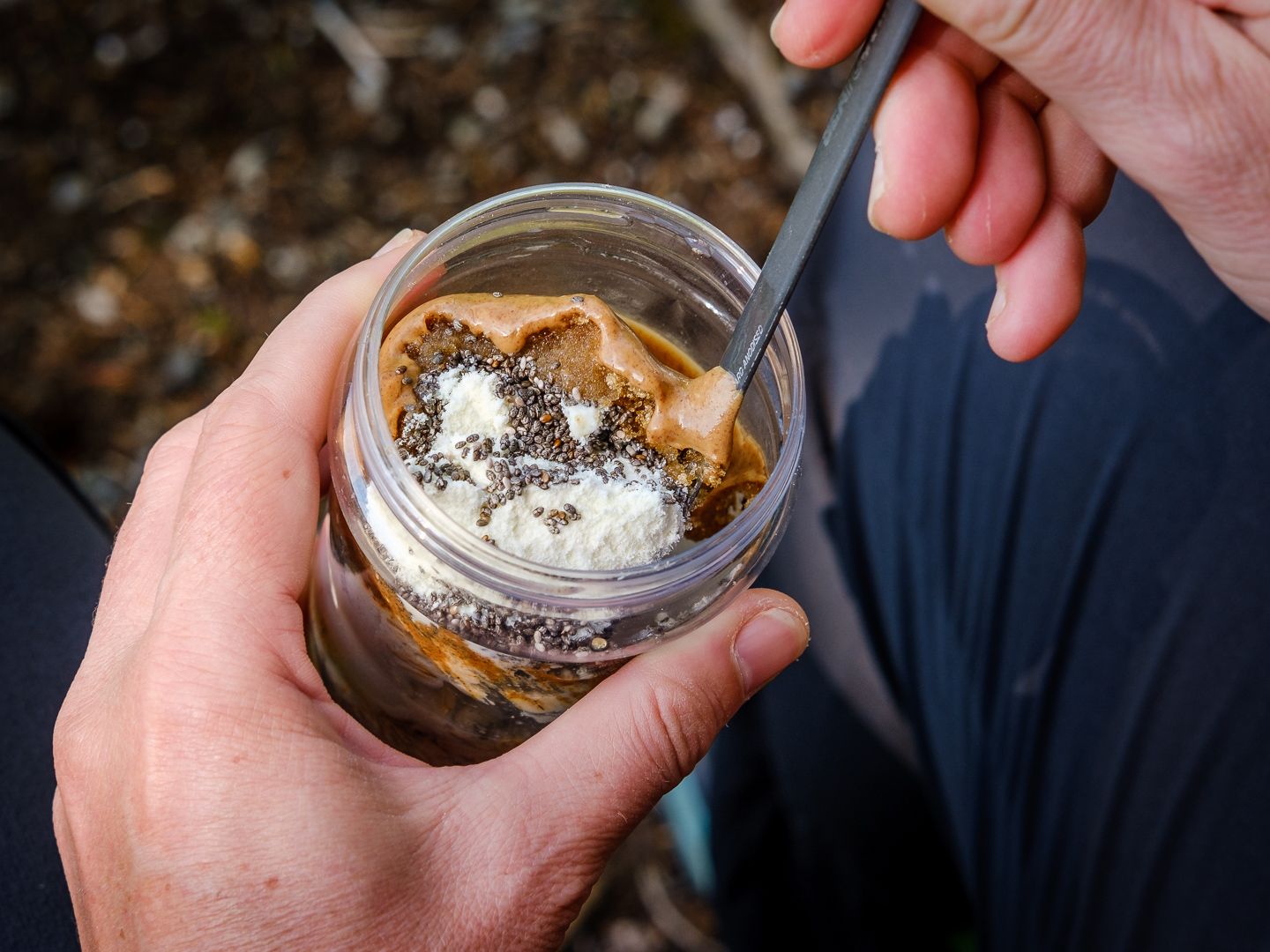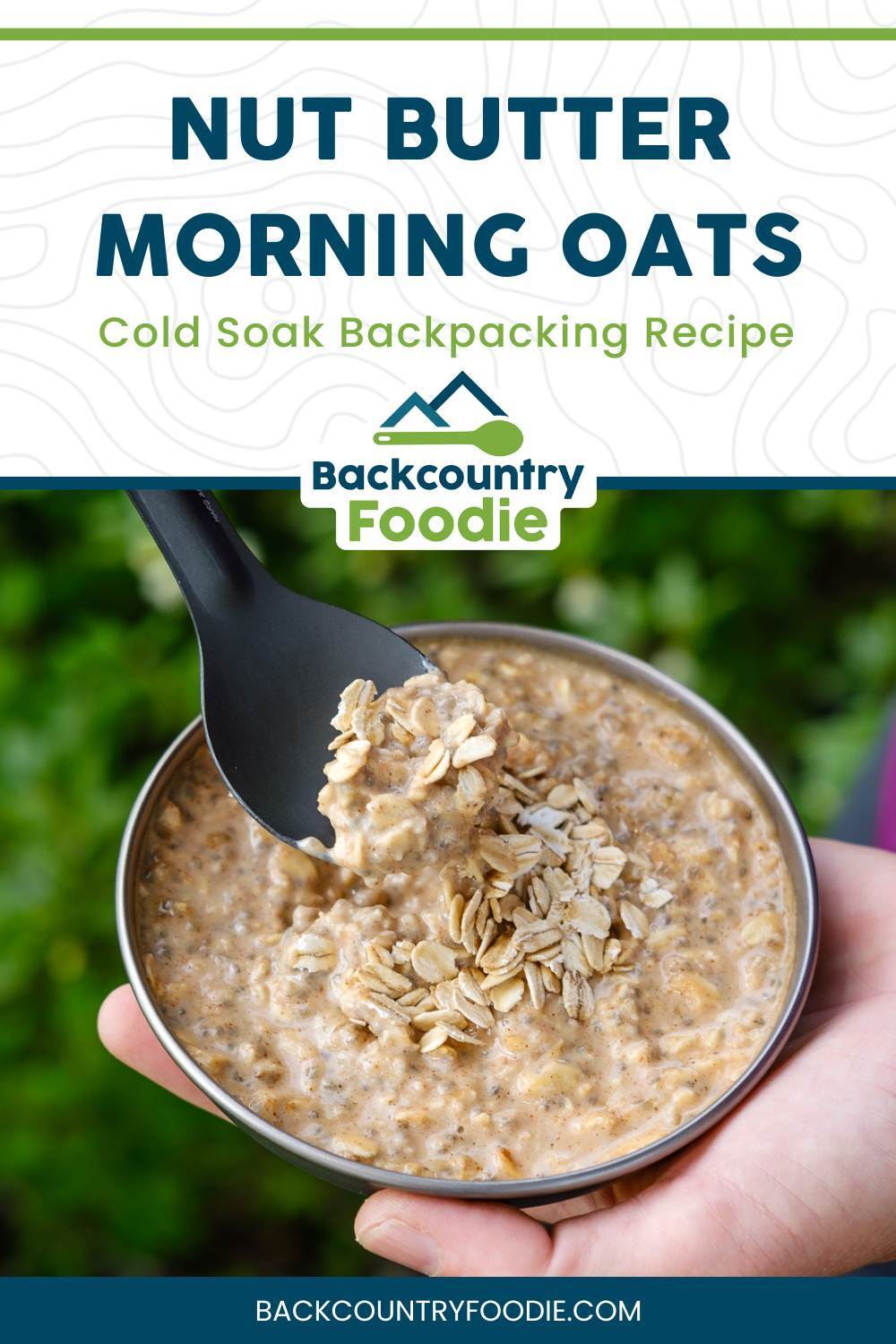Nut Butter Morning Oats | Ultralight Backpacking Recipe
By Aaron Owens Mayhew, MS, RDN, CD
Updated January 6, 2024
This post may contain affiliate links.

Do you like overnight oats for breakfast? Well, you can have them on the trail as well! This cold soak backpacking recipe is our version of overnight oats.
Unlike some cereals, Backcountry Foodie’s Nut Butter Morning Oats recipe…
✔️Packs in 23 grams per serving.
✔️ Provides 66 grams of complex carbohydrates for fueling your muscles.
✔️ It’s also an excellent source of fiber, with 13 grams per serving!



We suggest soaking the oats for up to an hour. Muesli fans, however, will enjoy it with less soaking time. Nut Butter Morning Oats makes a great starter recipe for cold soak beginners. It’s easy and will be tasty no matter how long you let it soak.
Looking for a hot oatmeal recipe? Maybe give our nutrition-packed and flavorful Lemon Blueberry Oatmeal recipe a try.
Don’t have time to prepare your own backpacking meals?
Not to worry. Our Build-a-Box Shop has everything you could possibly need to fuel your adventures!

Nut Butter Morning Oats
Rate This Recipe
View Comments / Leave A ReviewNUTRITION (per serving)
INGREDIENTS
- ½ cup (40 g) oats, old fashioned rolled
- ¼ cup (30 g) milk powder, whole
- 1 Tbsp (15 g) chia seeds
- 1 Tbsp (12 g) vanilla powder, Cook's® brand
- 1 Tbsp (14 g) brown sugar
- ⅛ tsp (0.3 g) cinnamon, ground
- 2 Tbsp (32 g) honey almond butter, or nut butter of choice, equivalent to 1.15 oz nut butter packet
- 5 oz (150 mL) water
OPTIONAL
- ½ cup oats, gluten-free old fashioned rolled oats (substitution), gluten-free option
- ¼ cup (17 g) milk powder, non-fat (substitution), reduced-calorie option
- almond milk powder (substitution), vegan, reflux-friendly option
- soy milk powder (substitution), vegan, reflux-friendly option
- brown sugar substitute (substitution), no-added-sugar option
- ¼ cup peanut powder (substitution)
INSTRUCTIONS (per serving)
HOME
- Put all dry ingredients in a bag or leakproof container to be used in the backcountry.
- Pack 2 Tbsp (32 g or 1 x 1.1 oz packet) nut butter of choice to be added to the meal when consumed.
FIELD
- Add 5 oz (150 mL) cold water to the bag or leakproof container with the dry ingredients.
- Stir to mix well.
- Add 2 Tbsp (32 g or 1 x 1.1 oz packet) nut butter to the mixture and stir to mix well.
- Let the mixture stand for at least 15 minutes allowing the oats to soften and mixture to thicken. Allow the meal to stand for up to 60 minutes to reach the consistency of overnight oats. See meal prep tip below.
- When the desired consistency is reached, stir to mix well and enjoy!
NOTES
MEAL PREP TIP
- We recommend consuming the meal within two hours of adding water, if reconstituted at >40℉ (4℃), to reduce food spoilage risk. Shorten this time period to 60 minutes if >90℉ (32℃).
NUTRITION
- Total sugar (per serving): 28 g including 13 g added sugar
- For a no-added-sugar recipe, replace brown sugar with a brown sugar substitute.
- Keep in mind the level of sweetness provided by alternative sweeteners. Adjust serving size accordingly.
- To reduce calories by 100, replace whole milk powder with non-fat milk powder.
ARE YOU SEARCHING FOR A MORE SUSTAINABLE FOOD STORAGE OPTION?
Consider checking out our biodegradable food pouches. The large pouches work great for freezer bag-style backpacking meals.

Ready to see more backpacking recipes like this one?
Backcountry Foodie is your go-to resource for over 200 backpacking dietitian-created recipes and a one-of-a-kind automated meal planning tool. The meal planner even creates itemized shopping lists for you! Meal prep has never been easier.

DISCLOSURE: Some of the links on this page are affiliate links, which means we may receive a modest commission if purchases are made through those links. This adds no cost to our readers and helps us keep our site running. Our reputation is our most important asset, so we only include links for products we use ourselves.
Did you enjoy this recipe?
Pin it and share it with your fellow hikers.

ABOUT THE AUTHOR
Aaron Owens Mayhew, MS, RDN, CD, is a registered dietitian and ultralight long-distance backpacker with over 20 years of nutrition and backpacking experience. She’s also the founder and owner of Backcountry Foodie, online ultralight recipes and meal planning platform for backpackers. She also enjoys teaching hikers about backpacking nutrition via virtual masterclasses, YouTube videos, and podcast episodes. You can follow Aaron’s adventures in the kitchen and the backcountry via Instagram and Facebook.





7 Comments
I made this recipe for breakfast at scout camp and it was delicious! I substituted vanilla whey protein powder for the milk powder and the vanilla powder and I thought it tasted like a cookie. I made 4 baggies to take to jamboree with me. I am bariatric surgery patient so I had trouble finishing the whole serving at once, but it was so tasty that I looked forward to eating the second half after my first shift on the archery range.
Has anyone put peanut butter powder in at the time of preparation, instead of nut butter at the time of consumption?
Adding peanut butter powder at the time of preparation instead of the nut butter packet when consumed would be fine. The difference would be the texture of the meal (less creamy) and fewer calories (nut butter is more calorically dense than peanut powder). You would also need to add more water to the meal to rehydrate the additional powder when it’s prepared.
If I make up small bags (vacuum packed) for trail use, why would I want to add the Nut Butter later instead of IN the mix? Thanks for your article, am printing it for my use.
I would expect the moisture in the nut butter to potentially cause the meal to mold. I’m also envisioning soggy oats. I added a note saying that the 2 Tbsp is equivalent to a 1.15 oz nut butter packet. Hope that helps.
Is there an alternative you’d recommend to the “1 Tbsp vanilla powder”, it isn’t something that is common in the UK?
The vanilla powder adds a nice flavor but isn’t essential for this recipe. It’s okay to leave it out.